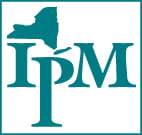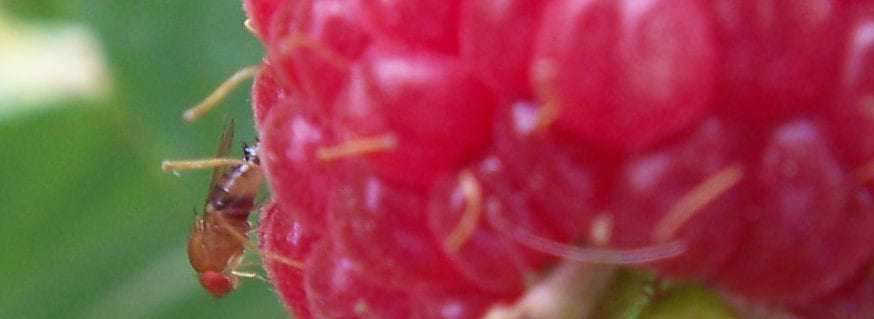This past season, 2020, we found a significant reduction of SWD in a raspberry planting using hummingbird feeders to attract ruby-throated hummingbirds into the planting.
In addition to nectar, ruby-throated hummingbirds feed on small, soft-bodied insects, snatching them directly out of the air or pulling them off plants. Early studies of hummingbirds raised in aviaries in Germany (Scheithauer 1967) used Drosophila melanogaster, the common fruit fly, to supplement their diet, without which they failed to thrive, proving unequivocally that hummingbirds require arthropods in their diet. If they can capture and eat D. melanogaster, it is certain that they can capture and eat D. suzukii, SWD. But will it help fruit growers?

Hummingbirds are known to learn how to find and use new food resources. They aren't picky eaters — eating small spiders, gnats, aphids, fruit flies, etc. Scheithauer (1967) even noted the behavior of hummingbirds to "buzz" the fruit flies to fan them off the surface they had settled onto. Once in the air, the hummingbird chased after an individual fruit fly until catching it and devouring it. Ruby-throats have been clocked at over 25 mph! And they can turn on a dime, which is about how much they weigh.
In western NY, one raspberry farm and one blueberry farm are actively utilizing hummingbird feeders in their operations (25 feeders/acre) as a management tactic for SWD. In 2020, plots on these farms were compared to plots on two others that did not use feeders to get at whether the feeders were helping against SWD.
The raspberry plots were on conventional farms and the floricane varieties were unknown. The raspberry farm without feeders was U-pick and implemented a conventional spray program, beginning when SWD was caught in traps and fruit were ripe. The raspberry farm using feeders was a CSA and did not apply insecticides.
The blueberry plots were on organic farms and both contained ‘Blueray’ (two rows) and ‘Bluecrop’ (one row). The organic blueberry farm without feeders was U-pick direct market and relied on sanitation and clean picking to manage SWD. The organic blueberry farm using feeders was direct market and used a single application of spinosad (Entrust) followed by a single application of pyrethrin (Pyganic) at labeled rates once SWD was caught and fruit were ripe.
Four rows, each 35.4 m (116 ft) long, were used for the experiment at each farm. Assessments for SWD were conducted in three of the four rows, one on the edge and two in the interior of the planting. Adult fly abundance was assessed weekly with Scentry SWD traps and lures. Samples of marketable fruits collected from each plot were assessed for fruit infestation using salt flotation to enumerate SWD larvae per gram of fruit using the method described by Van Timmeren et al. (2017).

Hummingbirds were seen at all observation time points from June through August in the berry plantings using feeders. None were seen in the plantings without feeders.
In 8 of 11 weeks, the raspberry plot with hummingbird feeders had statistically fewer SWD than the plot without feeders, especially in the latter half of the growing season. No statistical differences were observed in the SWD numbers between the blueberry plots.
Differences were seen in the fruit infestation levels in the raspberry plots with lower infestation in the plot with feeders. No differences were found between the blueberry plots in fruit infestation levels. In all farms, SWD fruit infestation levels were low in the marketable fruit samples collected: 0 to 0.78 larvae/g of fruit in blueberry and 0 to 0.04 larvae/g in raspberry.
We are currently preparing a manuscript for publication of this work and the prior field research experiments. The 4-year study in research plots was summarized in a Fruit Quarterly article (Carroll et al. 2020). The Spring issue (see page 9) is available at https://nyshs.org/wp-content/uploads/2020/06/NYFQ-BOOK-Spring-2020_FINAL.pdf.
The investigation of ruby-throated hummingbird predation of SWD in grower fields was done by Juliet Carroll and Grace Marshall, NYS IPM Program, with advice and guidance from Courtney Weber, Section of Horticulture and Greg Loeb, Department of Entomology. We are located at Cornell University, Cornell AgriTech, Geneva, NY
Funding to support this work has been provided by the New York State Berry Growers Association and the USDA NIFA CPPM EIP award 2017-70006-27142.
Literature cited:
Carroll, J., Weber, C., and Loeb, G. 2020. Hummingbirds can reduce spotted wing drosophila (SWD) fruit infestation. Fruit Quarterly 28(1): 9-13.
Scheithauer, W. 1967. Hummingbirds: flying jewels. Translated by G. Vevers. Arthur Barker Ltd and Thomas Y. Crowell Co., NY. 176 pp.
Van Timmeren, S., Diepenbrock, L. M., Bertone, M. A., Burrack, H. J., and Isaacs, R. 2017. A filter method for improved monitoring of Drosophila suzukii (Diptera: Drosophilidae) larvae in fruit. J. Integr. Pest Manag. 8: 1-7.

